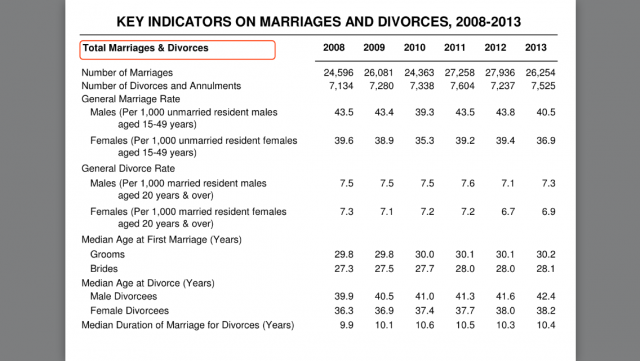Search the Community
Showing results for tags 'fewer'.
-
The Land Transport Authority has announced that there will be fewer certificates of entitlement for the next three months starting from February. There will be fewer certificates of entitlement (COE) for the next three months starting from February. The Land Transport Authority (LTA) said the supply of Category A COEs, which are for cars up to 1,600cc, will shrink by 9.1% to 3,300 a month. Category B (cars above 1,600cc) will have 2.9% fewer certificates at 2,471 a month. There will be 26.4% fewer open category COEs, which are for all vehicles except motorcycles, at 784 a month. Commercial vehicle buyers and sellers will have 25.2% fewer COEs at 1,651 per month. And motorcyclists will see a 7.6% dip in their COE supply to 608 pieces a month. In total, the supply is 12.9% smaller than the November-January quota.
- 93 replies
-
- 5
-

-

-
- coes
- feb 2019 coes lta
- (and 6 more)
-
Fast food meals have fewer calories than restaurant dishes, BMJ finds Fast food meals are less calorific than many restaurant dishes, research published in the BMJ has found. The study found that meals served by popular high street eateries - including Harvester and Hungry Horse - contain more than twice the amount of recommended calories. Health officials say that a main meal should contain no more than 600 calories. But the study found that the average dish served in a chain restaurant contains 1033 calories. The figure far exceeds the average 751 calorie countent found in meals served by fast-food joints including MacDonalds, Wimpy and Burger King. The biggest offenders were the Hungry Horse and Stone House restaurant chains, which which clocked up 1,358 and 1,275calories in an average main meal respectively. Other well-known restaurant chains with high calorie content included Harvester, at 1,166 calories, JD Wetherspoon, with 1119 calories, and Nandos, on 1,019 calories. Advice issued by Public Health England in March said people should be aiming to consume 600 calories for lunch and dinner. Author Dr Eric Robinson, a behavioural psychologist at Liverpool University, said the findings were "shocking". But he warned that they under-estimate the true picture, since drinks, starters, desserts and side orders were excluded from the study. He said: "Only one-in-ten of the meals we surveyed could be considered a healthy number of calories. "Although some of the results are shocking our findings probably underestimate the number of calories consumed in restaurants because our analysis did not include drinks, starters, desserts or side orders." He said: "It's really clear what the food industry need to do - they need to act more responsibly and reduce the number of calories that they're serving." Britain’s restaurant habits are fuelling its obesity crisis he said, with four in ten adults eat out at least once a week. Dr Robinson said the poor nutritional content of 'fast food' is well known but full service restaurants where dining tables are provided have received less attention. The study analysed the calories in 13,500 main meals from 21 full-service and six fast-food chains. Among fast food chains, meals at Burger King had an average of 711 calories, followed by Wimpy, at 721 calories, and McDonald’s at 726 calories. The highest meal in a restaurant classed as “fast-food” was at KFC, with an average of 987 calories. Dr Robinson said: "On average, the energy content of main meals served by full service restaurants was 268 calories higher than that of main meals served by fast food restaurants.” Researchers said many public health experts had focussed concern on fast foods, but not paid enough attention to the stodgy and fatty fare sold in high street restaurants. The UK is the most overweight nation in Western Europe - with levels of obesity growing faster than in the US. Last year a study by the Organisation for Economic Cooperation and Development (OECD) said Britain was the sixth-worst country in its 35 member states - coming behind Mexico, the USA, New Zealand, Finland and Australia. Two in three adults are overweight or obese. The Government is consulting on introducing mandatory calorie labels on restaurant menus, while health officials are working on plans to cut the calorie content of meals. https://www.msn.com/en-sg/health/fitness/fast-food-meals-have-fewer-calories-than-restaurant-dishes-bmj-finds/ar-BBQYCUr?ocid=spartanntp
-
Every year, more than a quarter of couple divorce. Good news is couples are getting marry at younger age but bad news is divorce also at earlier age. Years of marriage also get shorter before divorce.
-
Singapore's vehicle population has shrunk for the first time in more than 10 years, with car numbers showing the sharpest drop. Land Transport Authority statistics showed that the total vehicle population stood at 971,871 at end-June - 0.2 per cent down from 974,170 at the end of last year. The private car cohort shrank by 0.4 per cent to 604,633, from 607,292. Motor industry watchers attribute the rare contraction - the first since 2002 - to the small supply of certificates of entitlement (COEs). While starting to expand after seven consecutive years of shrinkage, the COE supply is still among the smallest in the last decade. This has to do partly with the Government's decision to restrict annual vehicle population growth rate to only 0.5 per cent - down sharply from 3 per cent. Not only that, industry players said there has been a clawback of COEs to make up for an oversupply in 2008 and 2009. Singapore Vehicle Traders Association secretary Raymond Tang said another contributing reason could be that "at the moment, many cars are booked, but stocks have not arrived". Hence the population contraction. Besides private cars, the numbers of buses, goods vehicles and motorcycles have also been shrinking. On the other hand, the taxi population grew marginally, but the rental car population truly bucked the trend by growing 6.5 per cent to 17,458. Motor traders said the rise in the rental fleet is fuelled by robust tourist arrivals and a growing expatriate community. In fact, the rental car population is more than double its size just nine years ago. Mr Neo Nam Heng, chairman of rental firm Prime Leasing, said his fleet has been growing by about 15 per cent a year. "Three years ago, we had around 700 cars, today, we have 1,000," he said. "There's been a lot of expatriates coming in." Looking ahead, industry players said the vehicle population shrinkage may come to a halt once the clawback of oversupplied COEs is completed next year. However, much depends on whether the Government will defer the release of an expected bonanza supply of COEs that will come on stream from next year. Transport Minister Lui Tuck Yew had said that he would prefer to keep some COEs for the next "dry spell" in 2019-2022. Mr Tang of the Singapore Vehicle Traders Association said if a percentage of COEs is kept for later years, the vehicle population contraction will continue. In fact, it may become more severe. While the market speculates that the Government might defer 20 to 50 per cent of the COEs due in the bonanza years of next year to 2017, Mr Tang reckons some clarity will emerge towards the end of the year. "I think by January, they will probably announce something," he added. Source: http://transport.asiaone.com/news/general/story/fewer-vehicles-singapore-roads
-
Commercial vehicles & m/cycles are going up ... From CNA: Fewer COEs next quarter, but more for cars There will be 3,777 Certificates of Entitlement for bidding each month, down from the previous quarter's 4,019, LTA said. SINGAPORE: The Certificate of Entitlement (COE) quota for the period August to October this year will be 11,331, the Land Transport Authority (LTA) announced on Wednesday (July 16). This means the monthly quota of COEs will be 3,777 for the period, down from 4,019 in the previous quarter. However, the number of COEs available for cars has increased due to a drop in the monthly quota of COEs for commercial vehicles and motorcycles. The monthly quota for Category A cars (up to 1,600cc and 130bp) has risen to 1,143 from 1,011 in the previous quarter, while the quota for Category B cars (above 1,600cc or 130bhp) is now 1,010, up from 966 in the previous quarter. For the open category, which can be used for any vehicle type but ends up mainly for bigger cars, the monthly COE supply will be 478, down from the previous quarter’s 586. Goods vehicles and buses will have a monthly supply of 515, down from 770, and motorcycles will have 631, down from 686. The next quota announcement for the bidding period of November 2014 to January 2015 will be made in October 2014, the LTA said. - CNA/kk
-
Really ........ CNA: Fewer motorists feel safe on roads in Singapore: survey SINGAPORE: Compared with three years ago, fewer motorists feel safe on the roads in Singapore, a survey of more than 450 drivers showed. In 2011, the AXA Road User Behaviour Survey found that 73 per cent of respondents perceived Singapore roads to be safe when it came to the risk of being involved in an accident. This dropped to 55 per cent this year, according to the latest survey which was released on Tuesday (June 3). The survey, commissioned by AXA Insurance Singapore in February, found that 62 per cent of the respondents felt that driving has become, on the whole, more unsafe, compared with the previous years. An “increase of aggressive drivers” was cited as the top reason. Although a majority of drivers believed the roads are unsafe, they also admitted to engaging in dangerous behaviour themselves, with 59 per cent of respondents citing “going through an amber light” as their most frequent behaviour. To promote safety awareness, the AXA Drive mobile application was launched on Tuesday and can be downloaded for free from the Apple iTunes Store and Google Play Store. It assesses one’s driving behaviour by looking into acceleration, braking and turning of the vehicle. Link: http://www.channelnewsasia.com/news/singapore/fewer-motorists-feel-safe/1135676.html Every countries have their own problem and city state like SG with land mass so small, chances of accident are great. Even in big country like Russia capital, Moscow, their driving are more aggressive... Aggressive drivers could be one of those drangerous drivers but 'weekends' drivers and foreign drivers also contribute to it. One just need to drive along Jalan Boon Lay in both direction can see a lot of bangala or Indian drivers speeding with their lorries on 1st lane...
- 76 replies
-
- 1
-

-
- general car discussion
- fewer
- (and 4 more)
-
The number of off-peak car (OPC) offences soared to a new high last year even as the population of red-plate cars continues to dwindle. According to the Land Transport Authority (LTA), there were about 23,160 offences last year, nearly twice the number in 2011 and about 19 times more than in 2009. An LTA spokesman attributed the spike to a more effective enforcement regime under the e-Day licence system, introduced in November 2009. Previously, OPC owners had to buy a paper permit and display it on the car's windscreen before driving. Source: http://www.straitstimes.com/breaking-news/...w-high-20130714 ----------------------------------- lesser OPC on the road..but 19 times more offences! this is uniquely Sinkapor
-
There were fewer road traffic accidents, including those involving fatalities, recorded last year despite the recent spotlight on serious cases of accidents here. Statistics released this morning by the Traffic Police show that there was a total of 7,168 accidents on the roads last year, which was 9.6 per cent lower than the 7,926 cases recorded in 2011. Fatal accidents also decreased from 195 to 169 or about 13 per cent over the same period. The number of traffic violations, however, was up about 4 per cent, from 316,214 to 327,503 cases. This means that about 900 people commit traffic offences everyday here. Source: http://www.straitstimes.com/breaking-news/...d-2012-20130201
-
The total number of accidents involving cyclists has gone down by 17 per cent between 2008 and last year. But every fatality is still one too many, said Parliamentary Secretary for Transport Muhammad Faishal Ibrahim, as he revealed these numbers in response to MPs' questions. With this in mind, the Transport Ministry is undertaking a number of initiatives to make it safer for cyclists, he said. New dedicated cycling paths are being built in seven neighbourhoods to separate cyclists from motorists and pedestrians, and the ministry is looking to link these intra-town cycling paths so that cyclists can commute between towns. To boost education in cycling safety, the Land Transport Authority will make new "Intra-Town Cycling" handbook available soon. It lists good cycling etiquette and safety tips for cycling. The Traffic Police and Home Affairs Ministry are also studying measures to inculcate a safe road-sharing mindset among motorists and cyclists, and are reviewing cycling penalties to ensure that they reflect the severity of the offences. Source: http://www.straitstimes.com/microsites/par...d-2011-20120910
-
Seems better odds of getting a PR approved than striking toto, 4D leh... 1 in 2 processed applications gets approved, machiam go casino play da siao (大小)also can win some how... tikum tikum may kena yes? Did not really know it is so easy to get a PR here. On a serious note, how stringent was/will be the control then and now? We are not against real talents e.g. Jim Rogers that bring great value to our nation as a PR per se. Or a tycoon becoming a PR and setting up companies to employ local folks. Instead what we see on the ground are supposingly talents (OMG, a PRC bus driver?) competing DIRECTLY with us for the same jobs but at a lower asking pay. Will we see a day they bring in Obama, Hillary as PRs then citizens to be in the cabinet? That will be the day.... Ok enough of ranting. Your views? http://www.channelnewsasia.com/stories/sin...1081613/1/.html Fewer foreigners granted PR status this year By Hetty Musfirah Abdul Khamid | Posted: 16 September 2010 1603 hrs SINGAPORE : With the tightening of immigration criteria since end of last year, Singapore will have fewer permanent residents this year compared to 2009, said Deputy Prime Minister Wong Kan Seng in Parliament on Thursday. He added that the country will manage the numbers to ensure quality of immigrants. Some 132,200 people applied to be permanent residents here last year. Of these, about 115,900 applications were processed, and 59,500 or 51 per cent were successful. Mr Wong told the House that of those granted PR status, the majority of them qualified under the Professional, Technical and Skilled Workers Scheme where they are contributing to the Singapore economy. Others who were granted permanent residency are dependants of Singapore Citizens or are dependants of these economic PRs. Mr Wong said the country will continue to be stringent in its requirements for PRs, welcoming those who can contribute to the economy and integrate well into society. "Singapore will have fewer PRs compared to the last five years. With the new criteria, and that means in future, the rate of increase will decline," said Mr Wong. Even so, Mr Wong said Singapore cannot afford to close its doors to immigrants. Mr Wong also told the House that an inflow of immigrants helps to improve the old-age support ratio by increasing the number of economically active residents. In 1970, when the country's total fertility rate (TFR) was above the replacement rate of 2.1, each elderly person was supported by 17 working adults. Currently, Singapore has about 8.2 working adults in the resident population supporting 1 elderly person. Mr Wong said that if there were no PRs, Singapore would have slightly fewer adults - with 7.2 working adults supporting 1 elderly person. He said: "We will still need immigration to make up for the short fall of babies and help ease the pressure of an ageing population, but we will carefully manage the numbers to ensure the quality of immigrants. "At the same time, we are careful not to allow the inflow of immigrants to upset the current mix of races in our population." Mr Wong assured that Singapore does not go overseas and target specific ethnic groups to come to Singapore. Unlike other countries, Singapore also does not have immigration consultants that advertise and help people migrate to Singapore unlike other countries. However, Mr Wong said that Singapore does offer scholarships to attract talent. Mr Wong said: "We have the ASEAN scholarships for example. And we also have companies who are out recruiting people and they are also interested in a heterogeneous and multinational workforce and because they have operations in other countries. They are also recruiting people by offering scholarships. "So we hope more of our companies can do that, and hopefully if they come here to work for awhile, they like (it here) and they may want to settle down." As for the new Population and Talent Division, Mr Wong said the government will look into areas like integration. It will start work at the beginning of next year. - CNA /ls
- 41 replies
-
- Fewer
- Foreigners
- (and 4 more)
-
HIGH certificate of entitlement (COE) prices are putting the brakes on off-peak car (OPC) sales, even as they were starting to take off after revisions were made recently to make such cars more popular with motorists. Now that car prices are in the alpine territory, the $17,000 tax rebate for buying an off-peak car no longer looks so attractive. First-quarter figures from the Land Transport Authority show a noticeable drop in new registrations of off-peak cars, which can be driven without a fee on weekends and between 7pm and 7am on weekdays. In the first three months of the year, a total of 1,639 new vehicles were put on the road, versus 2,160 in the same time last year and 2,637 in 2008. Because COE premiums, and consequently car prices, have soared in recent months, motor traders said the $17,000 rebate now represents a smaller saving. This has either turned off would-be buyers, or priced them out. Said Mr Teo Hock Seng, managing director of Hyundai agent Komoco Motors: 'A $17,000 saving on a $70,000 car is very different if the car was $35,000.' The cars have also simply become less affordable, rising in price by at least $20,000 in the last year. An entry-level off-peak car costs about $40,000 now. Mr Albert Pang, managing director of Chevrolet dealer Alpine Motors, said: 'When OPCs were about $20,000-plus, customers with monthly incomes of $1,000-plus could enter the market. Now, this group is absent.'
-
http://www.asiaone.com/News/the%2BStraits%...1112-99979.html better not complain too much complain about too crowded during rush hours, seats removed next time complain about lack of air-cond MRT remove the roof of the MRT train and when rain need to bring umbrella good luck to us
-
More vitamin D could mean fewer cancers: study Tue Sep 4, 2007 12:14 PM ET NEW YORK (Reuters Health) - Thousands of cases of breast and colon cancers might be averted each year if people in colder climates raised their vitamin D levels, researchers estimate in a new report. A number of studies have suggested that vitamin D may be important in cancer risk. Much of this research is based on cancer rates at different latitudes of the globe; rates of breast, colon and ovarian cancer, for example, are lower in sunnier regions of the world than in Northern climates where cold winters limit people's sun exposure. Sunlight triggers the synthesis of vitamin D in the skin, and people who get little sun exposure tend to have lower stores of the vitamin. Complementing these studies are lab experiments showing that vitamin D helps prevent cancer cells from growing and spreading, as well as some clinical trials in which people given high doses of vitamin D showed lower cancer risks. For the new study, researchers at the University of California used data on average wintertime blood levels of vitamin D and rates of breast and colon cancers in 15 countries. They found that rates of the diseases tended to fall as average vitamin D levels climbed, according to their report in the journal Nutrition Reviews. The protective effect against colon cancer seemed to begin when blood levels of vitamin D reached 22 nanograms per milliliter (ng/mL); for breast cancer, that number was 32 ng/mL. The average late-winter vitamin D level among Americans is 15 to 18 ng/mL, according to the researchers. They argue that, based on their data, if Americans were able to maintain a vitamin D level of at least 55 ng/mL, 60,000 cases of colon cancer and 85,000 cases of breast cancer could be prevented every year. Worldwide, those figures could be 250,000 and 350,000, respectively. "This could be best achieved with a combination of diet, supplements and short intervals -- 10 or 15 minutes a day -- in the sun," lead study author Dr. Cedric F. Garland, a cancer prevention specialist at the University of California San Diego, said in a statement. No one is recommending that people bake in the sun to reach high vitamin D blood levels. According to Garland, spending a matter of minutes in the midday sun, with 40 percent of the skin exposed, is enough. For fair-skinned people, the researchers estimate that just 3 minutes in the sun can be adequate, while darker-skinned people may need about 15 minutes. A lifeguard in Southern California, Garland said, may have little need for extra vitamin D to reach potentially protective levels, whereas a Northerner who tends to stay indoors much of the year may need much more. Garland and his colleagues recommend that, in addition to modest sun exposure, adults get 2,000 IU of vitamin D per day -- which is the "tolerable upper intake level" set by U.S. health officials. That limit exists because of the risk of vitamin D toxicity, which causes elevated calcium levels in the blood and problems such as nausea, weight loss, fatigue and kidney dysfunction. SOURCE: Nutrition Reviews, August 2007.
-
Market expects across-the-board reduction in COE numbers CAR buyers can expect higher certificate of entitlement (COE) premiums ahead, as far fewer cars are being scrapped this year. This is likely to mean fewer COEs in the highly anticipated October 2007-March 2008 mid-quota year review - and higher premiums. Prospective buyers will know the answer this month when the review is released. In fact, the market expects an across-the-board cut in COE numbers - the first time since mid-quota year reviews were introduced in 2001. COE supply hinges largely on a replacement principle. Land Transport Authority (LTA) figures show that the number of all vehicles taken off the road in the first seven months fell by 20 per cent to 52,195, compared to the same period last year. Since 2001, the LTA has in place a system to tweak COE supply in the middle of a quota year, to better match replacement demand. As it turned out, it has always released more COEs in the middle of each quota year, since actual scrappage has always far exceeded its estimates at the start of each quota year in April. For the past six years, the release of make-up COEs for October-March has led to a drop in premiums in the six-month period. But not this time. The number of cars scrapped in the first seven months just about matches what the LTA had forecast. The chief executive of multi-brand agent Jardine Cycle & Carriage's motor operations, Mr Cheah Kim Teck, said: 'Definitely, there will be no extras this time.' Going forward, he said COE supply in the next financial year starting April 2008 could fall by '15-16 per cent'. But he does not expect any drastic cut. The managing director of Toyota distributor Borneo Motors, Mr Mark Choong, agreed. 'I don't think there will be extra COEs coming onstream but I don't expect any significant reduction,' he said. Mr Choong said there might not even be much of a cut in the commercial vehicles quota, despite a sharp drop in the number of vans, trucks and buses taken off the road in the first seven months. 'Commercial vehicles are an economic necessity,' Mr Choong said, adding that higher concrete prices and higher cost of 'clean-diesel' commercial vehicles - mandatory from October 2006 - had already raised overall business cost. Mr Choong expects COE prices to climb from the current $16,000-$18,000 levels - 'but not just yet to $30,000-$40,000'. Motor traders expect the expanded presence of parallel importers and the arrival of used cars from abroad, following a relaxation of rules, to keep up bids for COEs. So, higher car prices seem almost certain. But even if premiums rise by $10,000, a Japanese sedan could still be had for below $70,000, compared to the more than $100,000 mid-1990s days. For sellers, the foreseeable drop in volume in the coming years could result in lower profits and downsizing. 'This is a feast-or-famine business,' said Cycle & Carriage's Mr Cheah.







